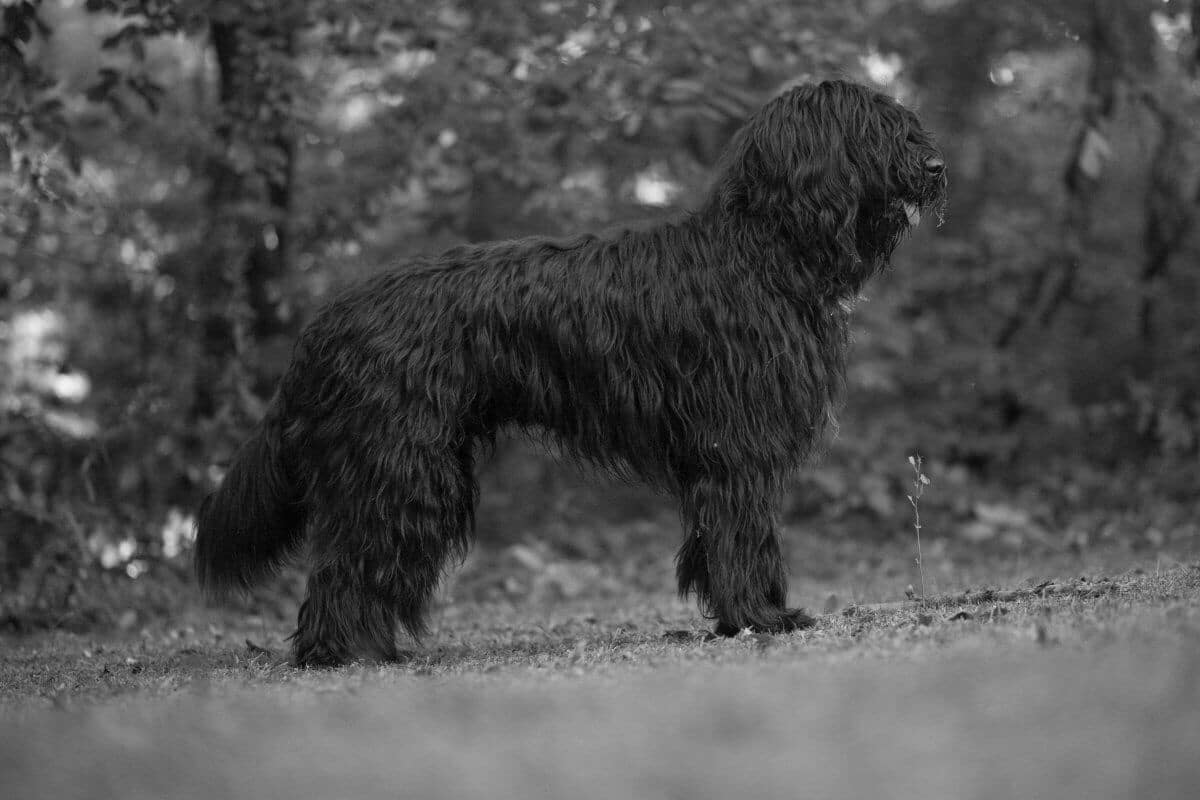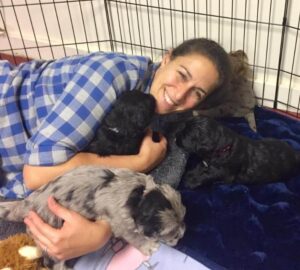
Alp Angel Bergamascos | Jeanine Dell’Orfano
Interview with Herding Group Breeder Jeanine Dell’Orfano – I live in Connecticut and have been involved with my breed, the Bergamasco
Home » Meet The Breeds » Bergamasco Sheepdog
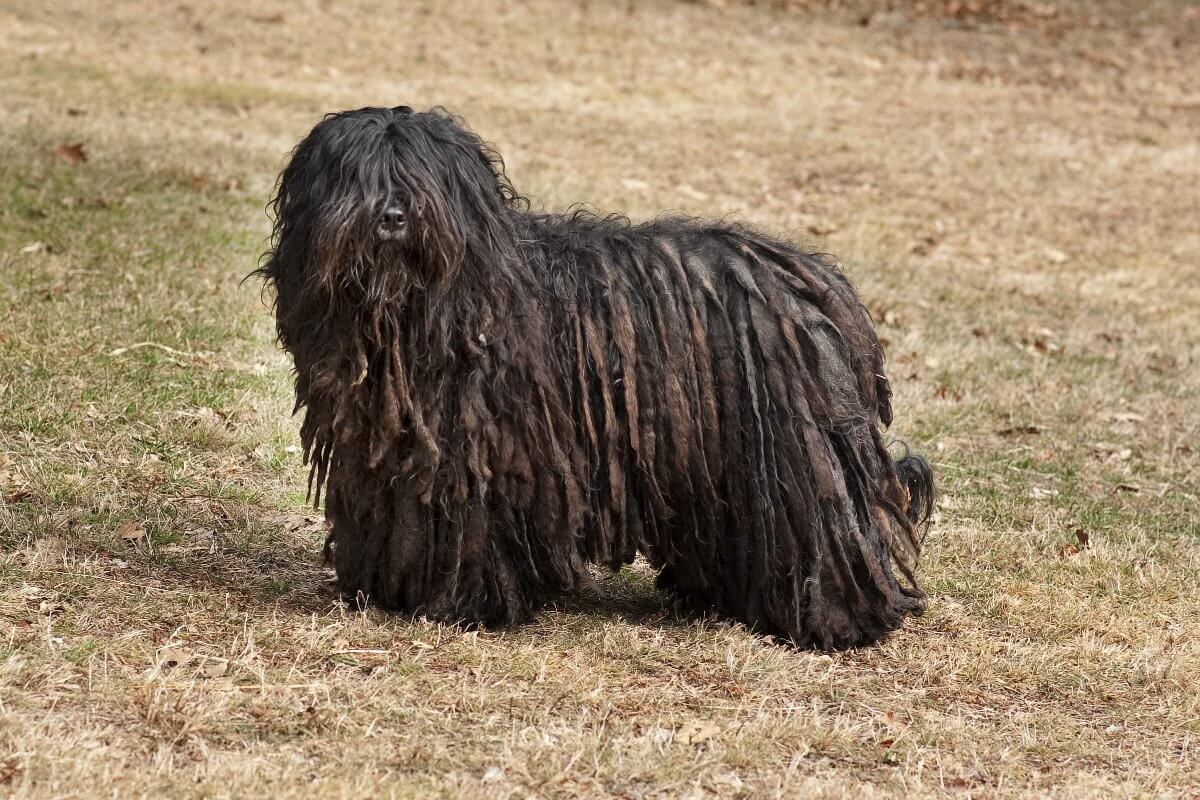
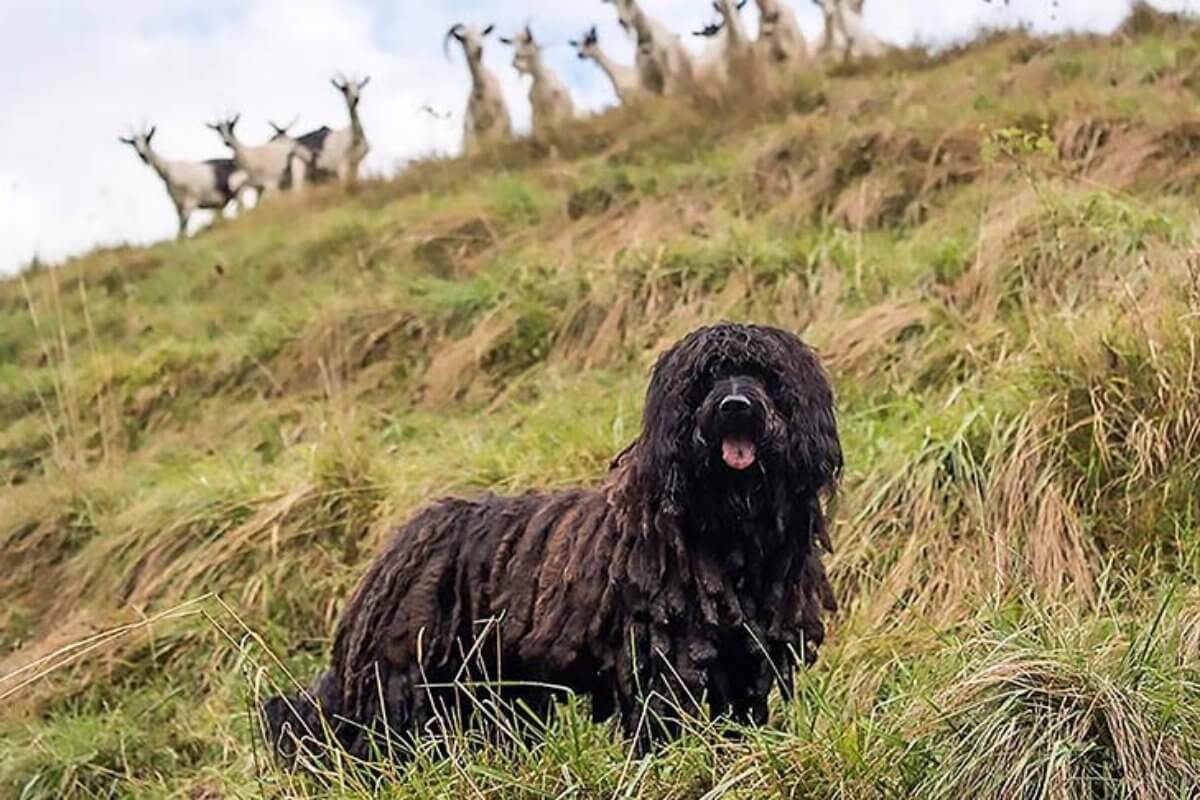
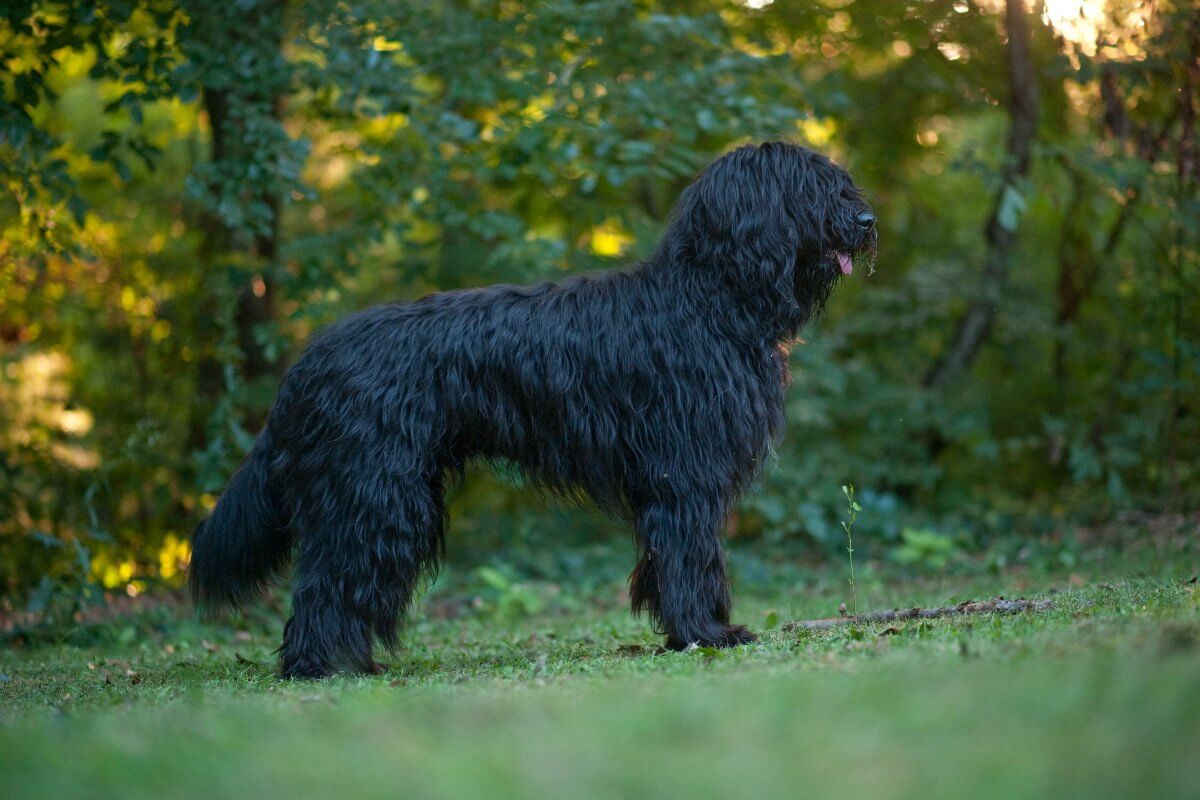
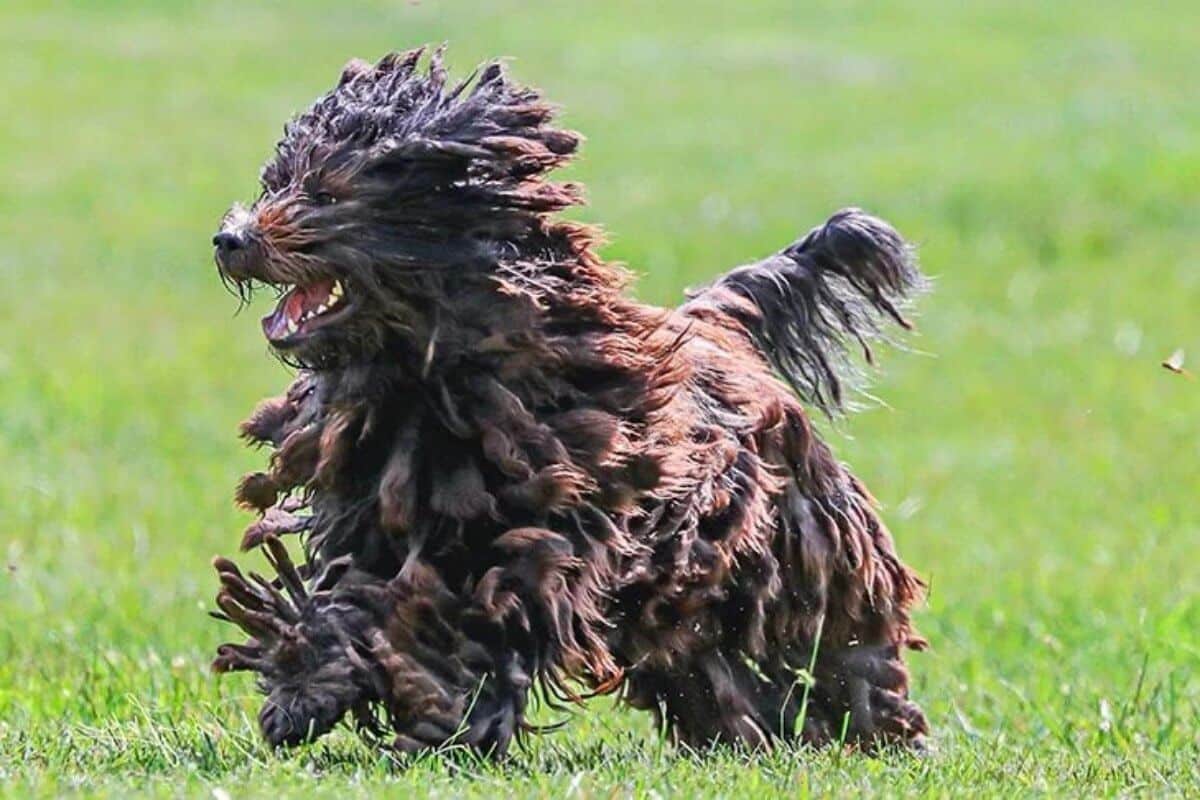
The Bergamasco Sheepdog, originally hailing from the Italian Alps, is a distinct heritage breed known for its unique, matted coat. Initially bred for herding and guarding livestock, this dog is characterized by its intelligence, loyalty, and steadfast demeanor. With ancient roots and a coat designed to protect it from harsh mountain weather, the Bergamasco has a rich history and a striking appearance that captures the attention of all who meet it.
Herding
22 – 23.5 Inches
57 – 85 Pounds
13 – 15 Years
| Country of Origin | Italy |
|---|---|
| Bred For | Herding, Guarding, Companionship |
| Known For | Intelligence, Vigilance, Loyalty, Rustic Appearance |
| Popularity | Low |
| Temperament | Independent, Intelligent, Sociable, Eager-to-Please |
| Activities | Herding, Hiking, Conformation Shows, Dog Sports |
The Bergamasco Sheepdog, with its uniquely flocked coat and keen herding instincts, boasts a rich history that traces back over two millennia. Originating in the European Alps, particularly in the Bergamo region of Italy from which it takes its name, this breed played an important role for many generations of herders as a loyal sheepdog.
Historical records suggest that the Bergamasco’s ancestors were brought to the Alpine regions by the ancient Phoenicians during their trade expeditions. Over time, as these dogs adapted to the harsh, mountainous terrain and cold climates of the Alps, they developed their distinctive coat, which served as protection against both predators and the elements.
The breed’s primary role was as a herder, guiding and protecting flocks in the challenging Alpine environment. With their innate intelligence, they often worked independently from their human handlers, making decisions to safeguard the sheep from any threats. This encouraged the development of a breed with a strong work ethic, independent thinking, and unparalleled loyalty.
While the Bergamasco Sheepdog has been an integral part of Alpine life for centuries, it remained relatively unknown outside of Italy for a long time. It wasn’t until the 20th century that enthusiasts began to introduce the breed to a broader audience, both in Europe and across the Atlantic in North America.
Official recognition by kennel club organizations took some time. The Bergamasco was officially recognized by the Fédération Cynologique Internationale (FCI) in the mid-20th century and was later recognized by the American Kennel Club (AKC) and The Royal Kennel Club (UK), further solidifying its position within the forganized dog world.
Despite its long history, the Bergamasco Sheepdog remains a rare breed. However, thanks to the efforts of dedicated breeders and enthusiasts, it continues to charm and impress those who encounter it, ensuring that its legacy and unique characteristics endure for future generations.
Adult male Bergamasco Sheepdogs ideally stand at 23.5 inches at the shoulder, while the mature female typically measures 22 inches. The breed’s height, however, can range from 21 to 25 inches.
In terms of weight, a male Bergamasco generally weighs between 70 and 84 pounds, with females weighing slightly less, ranging from 57 to 71 pounds.
The Bergamasco Sheepdog boasts a harmonious overall structure. The breed’s length, when measured from the point of the shoulder to the point of the buttock, tends to be about five percent more than the dog’s height at the withers. The height-to-length ratio is approximately 10:10.5 to 11. This gives the Bergamasco a very slightly longer profile. The breed’s substance is solid without appearing bulky, maintaining a rustic elegance that’s unique among purebred dogs. The Bergamasco’s build reveals a dog that’s equipped for endurance rather than speed, highlighting its historical role as a diligent herder and protector of flocks in a challenging alpine environment.
Texture: The Bergamasco Sheepdog is renowned for its unique coat, which consists of three different types of hair that combine to form characteristic flocks or mats. These flocks serve not only as a protective measure against the cold and predators, it also gives the breed its distinctive appearance. The coat’s texture can range from wooly to more hair-like, and as the dog ages, the coat changes and the flocks can reach the ground.
The Bergamasco’s coat takes years to mature and can vary considerably. The distribution, size, texture, and thickness of the flocks grow differently on every dog. The hair is composed of three hair types: undercoat, “goat hair,” and wooly hair. The undercoat provides insulation, with the other two types weaving naturally together to form flat, irregular flocks. The absence of wool is unacceptable; however, trimming is acceptable.
| Standard Color | |
|---|---|
| Gray | ee |
| Black | ee |
Markings: Gradations of Gray (including Merle)
A Note About Color: The Bergamasco is born solid gray in color or gradations of gray (including merle) up to and including solid black. The color tends t change to various shades as the dog matures. Black coloration in puppies (including black patch on merles) will typically lighten into shades of gray. Shadings of tawny-brown and fawn are typically seen at the lower part of the flocks due to the influence of the sun, water, and atmospheric factors as well as the aging of the hair. The overall appearance from a distance is of a reddish brown color. White markings are acceptable only if they do not exceed one-fifth of the total body area.
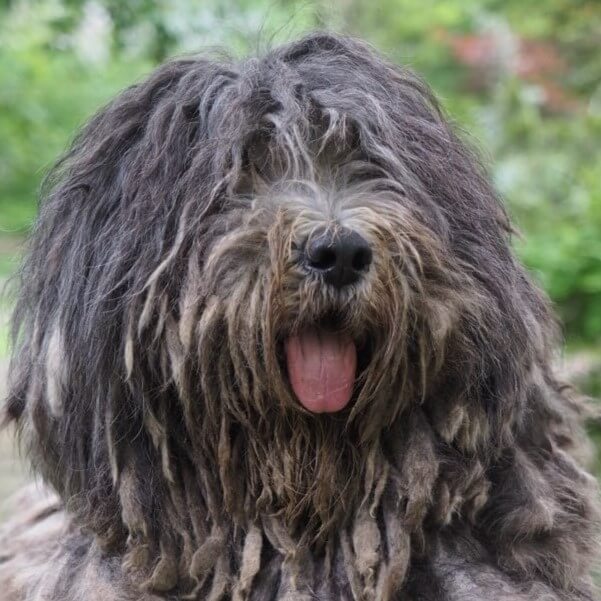
The Bergamasco Sheepdog’s tail is a defining feature, adding to the breed’s rustic silhouette. It is set low, extending from a natural line of the croup. In its relaxed state, the tail hangs down, reaching the hock or slightly below it. When the Bergamasco is in motion or alert, the tail can be raised, but it doesn’t typically curl over the back.
The tail is covered with dense, semi-long hair that can form slight waves, adding to the breed’s agrarian appeal. As per the Breed Standard, the Bergamasco’s tail is always undocked, allowing it to flag back-and-forth freely at a level higher than that of the topline.
Owning a Bergamasco Sheepdog is a rewarding experience, but potential owners should consider various aspects of this breed to ensure it matches a person or family’s lifestyle and expectations. This ancient herder, with its distinctive coat and diligent nature, requires specific care, attention, and understanding in order to thrive.
In general, the Bergamasco Sheepdog is a robust and healthy breed with a long lifespan, reflecting its origins as a hardy mountain dog.
Lifespan: The breed typically enjoys a lifespan of 13 to 15 years when given proper care, a balanced diet, and regular health check-ups.
The Bergamasco Sheepdog, although resilient by nature, is not exempt from certain health issues associated with many breeds and mixed breeds. It is important to note, however, that responsible breeders are the most reliable source for acquiring a well-bred Bergamasco. Some issues that should be addressed with breeders include:
In addition to these primary concerns, Bergamasco Sheepdog owners should also remain vigilant for potential ear infections, dental issues, and skin-related problems, considering the breed’s unique coat. Regular veterinary check-ups, a good diet, and routine exercise can help to mitigate the risks of these health issues.
The Bergamasco Sheepdog is recognized as a devoted, intelligent, and patient breed, embodying qualities that have been honed through generations of herding livestock. For those wondering if this breed is a good fit for novice owners, it’s worth noting that while the Bergamasco is patient and generally amiable, its intelligent and independent spirit can sometimes present challenges for those unfamiliar with dog training. These dogs benefit from consistent and understanding training approaches, making them potentially rewarding companions for even those new to dog ownership.
One of Bergamasco’s striking traits is its sensitivity. These dogs bond deeply with their families, often becoming finely attuned to the emotions and ambiance around them. This sensitivity means they tend to thrive with positive reinforcement during training and can become somewhat withdrawn if treated harshly. Their deep connection with their families also means they don’t take well to being left alone for long stretches. They flourish best when involved in family activities and given regular companionship.
With their herding lineage, Bergamascos generally exhibit good behavior around other dogs, especially if they’ve been socialized from a young age. This same background and their gentle, patient nature often make them excellent companions for families with children. They’re known to keep a watchful, protective eye on younger family members. This doesn’t mean, however, that they’re overly friendly with every new face they encounter. When it comes to strangers, the Bergamasco Sheepdog tends to be protective and might exhibit reserved behavior, being naturally cautious and observant around unfamiliar individuals.
In the company of those they trust and love, Bergamascos shine as both a loyal guardian and a diligent worker, perfectly balancing their roles as family companions and dependable working partners.
The Bergamasco Sheepdog, with its robust herding history, has specific dietary needs for staying healthy and energetic. It’s essential to remember that the right nutrition supports not only the dog’s physical health but also its unique coat and overall happiness.
For Bergamasco puppies, a high-quality puppy food designed for medium-to-large breeds is often recommended. As these young dogs are growing and developing, they require a diet rich in essential nutrients, proteins, and fats to support bone growth, muscle development, and overall health. Splitting their daily intake into multiple small meals can help to manage their rapid growth and ensure steady energy levels.
Once a puppy transitions to adulthood, the dietary needs of the Bergamasco shift. An adult Bergamasco typically requires a balanced diet with high-quality proteins as the primary ingredient. Given the breed’s active nature, the Bergamasco may need more calories than some less active breeds, but it’s essential to monitor the dog’s weight and adjust its food intake accordingly. The average adult might consume around 2 to 3 cups of high-quality dry dog food daily, depending on size, age, metabolism, and activity level. This amount should be divided into two meals to promote better digestion and prevent the risk of bloat, a condition to which deep-chested breeds can be susceptible.
Factors like pregnancy and nursing, or regular participation in rigorous activities, might necessitate adjustments in a Bergamasco’s daily food consumption. It’s always advisable to consult with a veterinarian to fine-tune the dog’s diet, especially if drastic changes are noticed in its weight or energy levels.
When considering the Bergamasco’s feeding routine, it’s also important to have a consistent schedule and a designated feeding area, which can provide a sense of routine and security. Fresh water should always be readily available, and treats should be given only in moderation, ensuring these don’t exceed 10 percent of the dog’s daily caloric intake.
Training a Bergamasco Sheepdog can be a rewarding experience, thanks to their innate intelligence and eagerness to please. Originating with a list of herding duties, these dogs were bred to be independent thinkers, capable of making decisions in the absence of their handlers. This independent streak, paired with an innate intelligence, means that training methods need to be engaging and varied to keep this breed interested.
Despite their independent nature, Bergamascos are generally eager to please their owners. This can be a double-edged sword: while they’re keen to learn and engage, they can sometimes try to outthink their trainers. For this reason, early training and socialization are crucial. Introducing them to a variety of people, places, and other animals during their formative months can go a long way towards ensuring a well-adjusted adult dog.
It’s essential to approach training with consistency. This breed responds best to methods that are firm yet fair. Harsh corrections or punitive measures can often be counterproductive with Bergamascos, given their sensitive nature. Positive reinforcement, like treats, praise, and play, tends to yield the best results.
Potential Bergamasco owners should be prepared for a vocal breed. They have a tendency to bark, often to alert their owners of strangers or potential threats. While this makes them effective watchdogs, it’s also a trait that can be managed with proper training.
Their herding background comes with a certain level of wanderlust. Given an opportunity, a Bergamasco might try to explore its surroundings, driven by curiosity and an instinctual drive to roam and survey.
The Bergamasco’s intelligence also means these dogs can have a high predation instinct. While they get along well with other animals they’ve been raised with, smaller pets might sometimes be seen as prey. Proper introductions and consistent training can help in managing this instinct.
Understanding the exercise needs of the Bergamasco Sheepdog is crucial for the overall well-being of these rustic creatures. Rooted in their herding lineage, these dogs come equipped with a moderate-to-high energy level, which means they require regular physical activity to keep them mentally stimulated and physically fit.
| Energy Level | Medium-High |
|---|---|
| Exercise Requirements | 1 Hour/Day (Minimum), Daily Walks, Vigorous Running, Regular Exercise, Playing with Another Dog, Mental Stimulation |
Bergamascos, despite their shaggy appearance, are dynamic dogs. Their exercise regimen should be more than just a leisurely walk around the block. Incorporating activities that engage both their mind and body will be beneficial. Play sessions, interactive games, and structured training exercises can be particularly effective in keeping them engaged.
However, the intensity of exercise should be tailored to their individual needs. While some Bergamascos might be content with a long walk followed by a play session, others might need more vigorous activities like fetch, agility training, or even herding exercises if the environment permits. It’s crucial to observe a Bergamasco and adjust its activities based on the dog’s energy levels.
Another noteworthy trait of the Bergamasco is its playfulness. These dogs often enjoy playing with toys, engaging in tug-of-war, or simply romping around in a secure yard. This playfulness can be a great way to bond with a dog and it provides a way to be sure it’s receiving enough physical activity.
However, exercise isn’t just about physical activity. Mental stimulation is equally crucial for this intelligent breed. Puzzle toys, obedience training, and even learning new tricks can help to keep the Bergamasco’s mind sharp and prevent potential behavioral issues that might arise from boredom.
The Bergamasco Sheepdog boasts a unique coat, which, while striking, requires a particular approach to grooming. It’s essential to understand the nuances of this breed’s coat to ensure it stays in optimal condition and that the dog remains comfortable.
| Coat Type | Complex, Three Types, Abundant Flocks |
|---|---|
| Grooming Requirements | Separating the Coat into Flocks at One Year, Infrequent Bathing, Routine Ear Cleaning, Periodic Nail Trimming, Regular Tooth Brushing |
At first glance, the Bergamasco’s coat might seem high-maintenance due to its distinct flocks – mats of hair that form naturally, creating a characteristic “corded” or “flocked” appearance. However, the reality is that their grooming needs, especially when it comes to regular upkeep, are quite minimal compared to many other breeds.
When they are young, Bergamascos have a soft, fluffy coat. As they mature, typically between 8 months to a year old, their adult coat starts to come in. Around this time, the coat begins its unique process of matting into individual flocks. As the dog’s owner, it’s beneficial to assist in this process by manually separating the flocks to ensure they don’t become too thick or large, which could lead to skin issues underneath. Once the flocks are fully formed, they serve as protection from the elements and potential predators, much as they did for the Bergamasco’s herding ancestors.
In terms of shedding, the Bergamasco’s unique coat means that any loose hair tends to get caught in the flocks rather than falling out freely. This results in minimal noticeable shedding around the house. However, this doesn’t mean they don’t shed at all; instead, the dead hairs are simply retained within the live coat.
While Bergamascos might not need frequent brushing, it’s crucial to regularly inspect the skin underneath the flocks for any signs of irritation, pests, or dirt buildup. Bathing is only necessary occasionally, and when it’s bath time, it’s vital to ensure the coat is thoroughly dried to prevent any mold or mildew from forming within the flocks.
In addition to coat care, regular grooming practices like nail trimming, ear cleaning, and dental care should also be a part of the Bergamasco Sheepdog’s grooming regimen.
The experience of living with a Bergamasco Sheepdog is genuinely unique, thanks to the breed’s rich heritage, distinct coat, and affable nature. However, understanding this dog’s specific needs can help to ensure a harmonious coexistence.
Given their herding background, one might assume that Bergamascos are best suited for open spaces or farms. While they do thrive in such environments, they’re also adaptable to apartment living, but only as long as their exercise needs are met consistently. Their moderate-to-high energy levels necessitate daily physical and mental stimulation, regardless of the size of the living space.
One significant consideration when living with a Bergamasco, especially in more confining spaces, is the dog’s coat. This breed’s unique flocked coat can collect dirt and debris, which is likely to get carried back into the house. Regular inspections and occasional baths can help to remedy this.
When it comes to weather considerations, the Bergamasco’s dense coat offers protection against cold temperatures. These dogs are well-suited for colder climates, and their flocks provide insulation against the cold. However, in hot weather, it’s essential to be cautious. The same coat that protects them in the cold can make them susceptible to overheating in overly hot conditions. During warmer months, it’s advisable to ensure they have access to shade and fresh water, and to avoid intense physical activity during the hottest parts of the day.
The Bergamasco Sheepdog’s sociable and loyal nature can make this breed a great companion. These dogs are protective of their families, often forming strong bonds with their human counterparts. This loyalty, combined with the breed’s intelligence, can sometimes lead to the Bergamasco being reserved or wary of strangers. Early socialization can help to encourage a balanced temperament and reduce any tendency towards over-protectiveness.
The sight of a Bergamasco Sheepdog puppy, with its soft, fluffy coat and curious eyes, is truly enchanting. Like all puppies, Bergamascos in their early days are playful, inquisitive, and filled with boundless energy. It’s during these crucial early months that the foundation for a well-adjusted adult dog is laid.
When it comes to caring for a Bergamasco puppy, there are certain considerations and practices that can ensure the pup grows up to become a healthy and well-adjusted adult.
One of the first noticeable traits of Bergamasco puppies is their soft, wool-like coat. As they mature, this coat will undergo a transformation, forming the breed’s distinctive flocks. Owners can assist in this natural matting process, making sure the flocks don’t become overly thick or cumbersome. Regularly inspecting the skin underneath, even at a young age, helps in identifying any potential issues early on.
Nutrition plays a pivotal role in the growth and development of a Bergamasco puppy. Ensuring the pup is fed a balanced diet, formulated specifically for puppies, can support its growth phase and maintain its overall health. Monitoring the puppy’s weight and ensuring it isn’t overfed is also vital, as obesity can lead to various health issues later in life.
Training and socialization should begin early. Given the Bergamasco’s intelligence and independent nature, introducing the puppy to basic commands and making sure it’s exposed to various environments, sounds, and experiences will undoubtedly shape its temperament. Positive reinforcement techniques will often work best with this breed.
Puppy-proofing the living environment is essential. Like all young dogs, Bergamasco puppies are curious and can sometimes get into mischief. Ensuring that potential hazards, like electrical cords or toxic plants, are out of reach can create a safer space for them to explore.
Regular vet check-ups, vaccinations, and preventive treatments for parasites are critical components of puppy care. Building a relationship with a trusted veterinarian will all but guarantee the puppy will be put on the right track health-wise.
In essence, caring for a Bergamasco Sheepdog puppy requires dedication, patience, and knowledge. With the right approach, these young dogs can blossom into loyal, intelligent, and well-adjusted adults.
Engaging a Bergamasco Sheepdog in activities and dog sports can provide this heritage breed with essential physical and mental stimulation. The versatility of these dogs allows them to excel in various activities. Here’s a list of some of the most suitable arenas and sports events for this breed:
In essence, whether it’s showcasing their legacy in herding, testing their agility, or putting their obedience to the test, Bergamasco Sheepdogs thrive in a myriad of activities and dog sports.
The Bergamasco Sheepdog is recognized by the world’s leading registries and kennel organizations, which categorize the breed into a specific Group based on its unique characteristics. This breed is recognized worldwide under the following Group designations:
| Organization | Group Designation |
|---|---|
| AKC (American Kennel Club) | Herding |
| UKC (United Kennel Club) | Herding Dog |
| CKC (Canadian Kennel Club) | Herding |
| ANKC (Australian National Kennel Council) | Working |
| RKC (The Royal Kennel Club) | Pastoral |
| FCI (Fédération Cynologique Internationale) | Group 1: Sheepdogs and Cattledogs Section 1: Sheepdogs |
The ideal Bergamasco Sheepdog is described by a Breed Standard that is approved by each of the world’s leading registries and kennel organizations. The Breed Standards for this breed may be found in the following links:
| Organization | Breed Standard |
|---|---|
| American Kennel Club | AKC Bergamasco Sheepdog Breed Standard |
| United Kennel Club | UKC Bergamasco Sheepdog Breed Standard |
| Canadian Kennel Club | CKC Bergamasco Sheepdog Breed Standard |
| Australian National Kennel Council | ANKC Bergamasco Sheepdog Breed Standard |
| The Royal Kennel Club | RKC Bergamasco Sheepdog Breed Standard |
| Fédération Cynologique Internationale | FCI Bergamasco Sheepdog Breed Standard |
Breed clubs play an essential role in the preservation and promotion of specific dog breeds. For the Bergamasco Sheepdog, these organizations have been instrumental in safeguarding the breed’s survival and continued recognition in the dog-loving community.
In the United States, the primary breed club dedicated to the Bergamasco Sheepdog is the Bergamasco Sheepdog Club of America (BSCA). This organization serves as a central hub for breed enthusiasts, offering resources on the Breed Standard, breed health, social events, and more. The club’s members work tirelessly to ensure the Bergamasco’s health, temperament, and working ability are maintained.
In Canada, the Bergamasco Shepherd Association of Canada champions the breed, providing resources and hosting events to highlight and celebrate the Bergamasco Sheepdog’s unique qualities.
In the United Kingdom, the Bergamasco Sheepdog Club UK stands as the main organization supporting the breed. This club is dedicated to the promotion, protection, and betterment of the Bergamasco Sheepdog.
The journey of a Bergamasco Sheepdog doesn’t always follow a straight path, and sometimes these dogs find themselves in need of a second chance. Rescue organizations, both breed-specific and general, work tirelessly to ensure that these unique sheepdogs find loving, forever homes.
In the United States, while there might not be a rescue group devoted solely to the Bergamasco Sheepdog due to its rarity, several all-breed rescue organizations and shelters often come across this breed. It’s recommended for potential adopters to check with the Bergamasco Sheepdog Club of America (BSCA) for guidance on rescues or rehoming situations involving Bergamascos.
For those in Canada, the situation is similar. While there might not be a Bergamasco-specific rescue group, the Bergamasco Shepherd Association of Canada could provide assistance or direct prospective adopters to trusted all-breed rescues that may have a Bergamasco in need.
In the United Kingdom, the Bergamasco Sheepdog Club UK can act as a resource for those interested in adopting or assisting Bergamascos in search of love and permanent companionship.
Yes, Bergamasco Sheepdogs are thought of as good family dogs. They are known for their patient, gentle, and loyal nature, which makes them great companions for families. They can form deep bonds with their family members, and their intelligent and independent nature allows them to coexist well with children.
The Bergamasco Sheepdog can potentially be trained as a service dog due to its intelligent and intuitive nature. These dogs are naturally attentive and tuned in to the needs of their human companions, which is a foundational quality for service dogs. However, it is essential to remember that individual temperament and training will play significant roles in determining a dog’s suitability as a service dog.
While Bergamasco Sheepdogs are independent and able to entertain themselves for a while, it is not advisable to regularly leave them alone for extended periods. Like all dogs, they thrive on companionship and interaction with their families. Extended periods of solitude can lead to feelings of loneliness and might result in undesirable behaviors stemming from boredom and anxiety.
Bergamasco Sheepdogs have a moderate maintenance level. While their unique coat might look like it demands a lot of care, it is relatively low-maintenance once the flocks have fully formed, requiring only occasional trimming to maintain. However, they do have exercise needs that must be met regularly to keep them healthy and happy.
Bergamasco Sheepdogs have a moderate tendency to bark. While they are not known to be excessively noisy, they are alert and will likely bark to alert you to new situations or perceived threats. It is always a good practice to train the Bergamasco from a young age to manage its barking tendencies appropriately and to ensure that it understands when it is (and isn’t) appropriate to bark.
Yes, like most dog breeds, Bergamasco Sheepdogs shed. However, due to their unique coat structure, the shedding hairs tend to get caught in the flocks, reducing the amount of loose hair around the house. Regular grooming and maintenance of the coat can help to manage the shedding and keep any Bergamasco looking its best.
Traditionally, Bergamasco Sheepdogs are not used as hunting dogs; their primary role has been herding and guarding livestock. Their natural abilities are more aligned with protection and guidance, utilizing their intelligence and independence to look after the flock. However, every dog is an individual, and it is not entirely out of the realm of possibility for a Bergamasco Sheepdog to be trained for hunting, though it might not be the most natural fit for the breed’s typical characteristics and skill set.

Interview with Herding Group Breeder Jeanine Dell’Orfano – I live in Connecticut and have been involved with my breed, the Bergamasco
The best way to ensure a long and happy relationship with a purebred dog is to purchase one from a responsible breeder. Not sure where to begin?
Contact the National Parent Club’s Breeder Referral Program, which is listed on the AKC Breeder Referral Contacts page.
